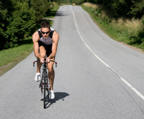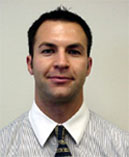 Training
for a triathlon can be a challenging task. Improper training
can lead to poor performance and worse yet an injury. Common
factors which can result in an increase likelihood of injury
can include and is not limited to: training errors, anatomic
and biomechanical factors, improper footwear, gender, age,
experience and a history of previous injury. The article
below will discuss training errors and injuries associated
with training for a triathlon.
Training
for a triathlon can be a challenging task. Improper training
can lead to poor performance and worse yet an injury. Common
factors which can result in an increase likelihood of injury
can include and is not limited to: training errors, anatomic
and biomechanical factors, improper footwear, gender, age,
experience and a history of previous injury. The article
below will discuss training errors and injuries associated
with training for a triathlon.
Training Errors and Injuries
Experienced runners are as likely to make the same mistakes
as beginner runners (1). Factors to consider when training for
running are not to increase your running distance too soon
and to avoid a sudden change in the transition of your
program.
A training program should consist of hard or quality days
with interspersed easy days to allow for recovery (1). Most
athletes can safely tolerate 3 hard days a week. When
training for distance, the weekly increase in mileage should
be no more than 5-10% (1). For example, if an individual is
currently running 20 miles a week, he or she should only
increase the distance to 21-22 miles for the following week.
An ideal training program is at a level just below “the
line” at which an injury becomes a serious risk. Injuries
usually occur when emphasis is placed on training the
aerobic system while disregarding the ability of the
musculoskeletal system to accommodate (1). Setting appropriate
goals and incorporating common sense is essential to
minimize the occurrence of an injury as well.
 Should
an injury occur which is mild, an individual should reduce training
for the activity which causes pain: i.e. biking, swimming or
running. It is usually more acceptable to reduce training rather
than cease training altogether if the injury is not serious. When
injured, it is often common for the individual to maintain aerobic
conditioning at all costs by performing cross training with no or
low impact activities and integrating replacement sources of fitness
training (1). Such activities can include running in the water, spending
more time on the bike, steppers and elliptical training (1). Mileage,
frequency and pace of an activity can also be adjusted to minimize
exacerbation of the injury while maintaining performance.
Should
an injury occur which is mild, an individual should reduce training
for the activity which causes pain: i.e. biking, swimming or
running. It is usually more acceptable to reduce training rather
than cease training altogether if the injury is not serious. When
injured, it is often common for the individual to maintain aerobic
conditioning at all costs by performing cross training with no or
low impact activities and integrating replacement sources of fitness
training (1). Such activities can include running in the water, spending
more time on the bike, steppers and elliptical training (1). Mileage,
frequency and pace of an activity can also be adjusted to minimize
exacerbation of the injury while maintaining performance.
With running when injured, often times the injured tissue is
able to sustain a moderate amount of stress which is evenly
distributed throughout the week, but unable to take longer
runs (1). Injured tissue may be able to take 10 miles in 2 days
of running but not the stress of a six mile run. Therefore,
the individual can run two consecutive five mile days rather
than a six and four mile day. A common modification is to
simply take your weekly mileage and split it into equal
distant runs. The weekly mileage stays intact, but there is
more control and understanding of the pain level per weekly
mileage. A typical progression is to start running every
other day at that distance and increase it by one half mile
every other workout (1). Please remember that these are general guidelines and that
you should
contact your physical therapist, physician or athletic trainer for
obtainment of a training program specific to yourself and your
injury.
Last revised: May 5, 2008
by Kevin Conto, MPT, L-ATC
References
1. Brotzman S.B., Wilk K. (2003). Clinical Orthopaedic
Rehabilitation. Philadelphia, PA: Mosby.


 Training
for a triathlon can be a challenging task. Improper training
can lead to poor performance and worse yet an injury. Common
factors which can result in an increase likelihood of injury
can include and is not limited to: training errors, anatomic
and biomechanical factors, improper footwear, gender, age,
experience and a history of previous injury. The article
below will discuss training errors and injuries associated
with training for a triathlon.
Training
for a triathlon can be a challenging task. Improper training
can lead to poor performance and worse yet an injury. Common
factors which can result in an increase likelihood of injury
can include and is not limited to: training errors, anatomic
and biomechanical factors, improper footwear, gender, age,
experience and a history of previous injury. The article
below will discuss training errors and injuries associated
with training for a triathlon.  Should
an injury occur which is mild, an individual should reduce training
for the activity which causes pain: i.e. biking, swimming or
running. It is usually more acceptable to reduce training rather
than cease training altogether if the injury is not serious. When
injured, it is often common for the individual to maintain aerobic
conditioning at all costs by performing cross training with no or
low impact activities and integrating replacement sources of fitness
training (1). Such activities can include running in the water, spending
more time on the bike, steppers and elliptical training (1). Mileage,
frequency and pace of an activity can also be adjusted to minimize
exacerbation of the injury while maintaining performance.
Should
an injury occur which is mild, an individual should reduce training
for the activity which causes pain: i.e. biking, swimming or
running. It is usually more acceptable to reduce training rather
than cease training altogether if the injury is not serious. When
injured, it is often common for the individual to maintain aerobic
conditioning at all costs by performing cross training with no or
low impact activities and integrating replacement sources of fitness
training (1). Such activities can include running in the water, spending
more time on the bike, steppers and elliptical training (1). Mileage,
frequency and pace of an activity can also be adjusted to minimize
exacerbation of the injury while maintaining performance.




